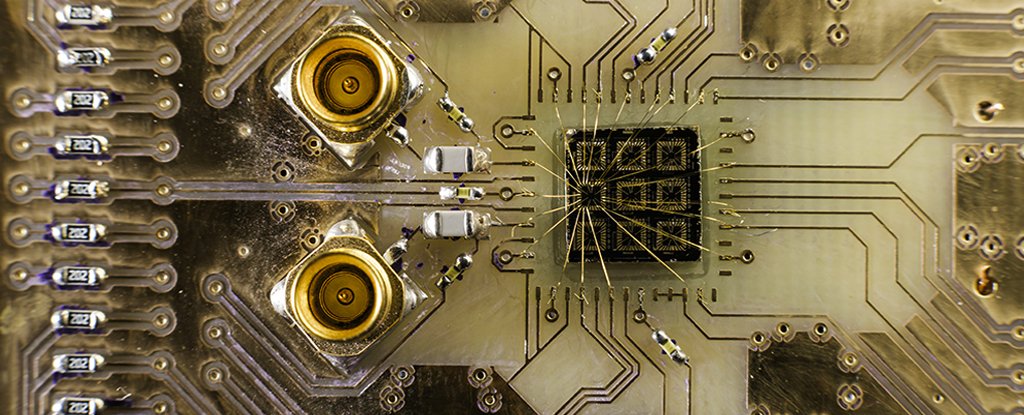Products You May Like
By making use of the ‘spooky’ laws behind quantum entanglement, physicists think have found a way to make information leap between a pair of electrons separated by distance.
Teleporting fundamental states between photons – massless particles of light – is quickly becoming old news, a trick we are still learning to exploit in computing and encrypted communications technology.
But what the latest research has achieved is quantum teleportation between particles of matter – electrons –something that could help connect quantum computing with the more traditional electronic kind.
“We provide evidence for ‘entanglement swapping,’ in which we create entanglement between two electrons even though the particles never interact, and ‘quantum gate teleportation,’ a potentially useful technique for quantum computing using teleportation,” says physicist John Nichol from the University of Rochester in New York.
“Our work shows that this can be done even without photons.”
Entanglement is physics jargon for what seems like a pretty straightforward concept.
If you buy a pair of shoes from a shop and leave one behind, you’ll automatically know which foot it belongs to the moment you get home. The shoes are – in a manner of speaking – entangled.
If the shopkeeper randomly pulls out its matching partner when you return, you’ll think they either remembered your sale, made a lucky guess, or were perhaps a little ‘spooky’ in their prediction.
The real weirdness arises when we imagine your lonely shoe as being both left and right at the same time, at least until you look at it. At that very moment, the shoe’s partner back at the shop also snaps into shape, as if your sneaky peek teleported across that distance.
It’s a kind of serendipitous exchange that Einstein felt was a little too spooky for comfort. Nearly a century after physicists raised the possibility, we now know teleportation between entangled particles is how the Universe works on a fundamental level.
While it’s not exactly a Star Trek-type teleportation that could beam whole objects across space, the mathematics describing this information jump are mighty useful in carrying out special kinds of calculations in computing.
Typical computer logic is made up of a binary language of bits, labelled either 1s and 0s. Quantum computing is built with qubits that can occupy both states at once – providing far greater possibilities that classical technology can’t touch.
The problem is the Universe is like a big jumble of shoes, all threatening to turn your delicate game of ‘guess which foot’ into a nightmare gamble the moment any qubit interacts with its environment.
Manipulating photons to transmit their entangled states is made easier thanks to the fact they can be quickly separated at light speed over huge distances through a vacuum or down an optical fibre.
But separating entangled masses – such as pairs of electrons – is more of a challenge, given their clunky interactions as they bounce along are almost certain to ruin their mathematically pure quantum state.
It’s a challenge well worth the effort, though.
“Individual electrons are promising qubits because they interact very easily with each other, and individual electron qubits in semiconductors are also scalable,” says Nichol.
“Reliably creating long-distance interactions between electrons is essential for quantum computing.”
To achieve it, the team of physicists and engineers took advantage of some strange fine print in the laws that govern the ways the fundamental particles making up atoms and molecules hold their place.
Any two electrons that share the same quantum spin state can’t occupy the same spot in space. But there is a bit of a loophole that says nearby electrons can swap their spins, almost as if your feet could swap shoes if you bring them close enough.
The researchers had previously shown that this exchange can be manipulated without needing to move the electrons at all, presenting a potential method for teleportation.
This latest advance helps bring the process closer to technological reality, overcoming hurdles that would connect quantum weirdness with existing computing technology.
“We provide evidence for ‘entanglement swapping,’ in which we create entanglement between two electrons even though the particles never interact, and ‘quantum gate teleportation,’ a potentially useful technique for quantum computing using teleportation,” says Nichol.
“Our work shows that this can be done even without photons.”
Of course, we’re still some way off replacing photons with electrons for this kind of quantum information transfer. The researchers haven’t gone as far as measuring the states of electrons themselves, meaning there could still be all kinds of interference to iron out.
But having strong evidence of the possibility of teleportation between electrons is an encouraging sign of the possibilities open to future engineers.
This research was published in Nature Communications.
